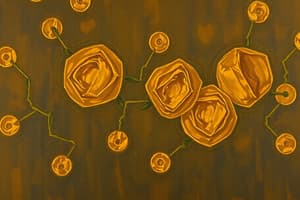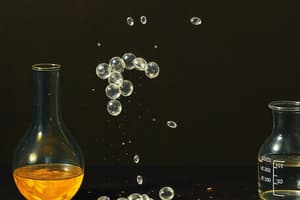Podcast
Questions and Answers
What type of intermediate is formed in the hydrohalogenation reaction?
What type of intermediate is formed in the hydrohalogenation reaction?
- Organometallic intermediate
- Carbocation (correct)
- Free radical
- Carbanion
What is the major product of the hydrohalogenation reaction?
What is the major product of the hydrohalogenation reaction?
- Markovnikov products (correct)
- Alkenes
- Aldehydes and ketones
- Alkyl halides
What is the difference between the hydration of alkenes and alkynes?
What is the difference between the hydration of alkenes and alkynes?
- One involves a free radical intermediate, while the other involves an organometallic intermediate
- One results in alcohols, while the other results in carbonyl derivatives (correct)
- One involves a carbocation intermediate, while the other involves a carbanion intermediate
- One results in aldehydes, while the other results in ketones
What is the general reaction type that involves the addition of halogens to alkynes?
What is the general reaction type that involves the addition of halogens to alkynes?
What is the product formed in the halogenation of alkynes?
What is the product formed in the halogenation of alkynes?
What is the reaction type that involves the addition of water to alkynes?
What is the reaction type that involves the addition of water to alkynes?
What is the reaction that involves the addition of hydrogen to alkynes?
What is the reaction that involves the addition of hydrogen to alkynes?
What is the reaction that involves the cleavage of alkynes using ozone?
What is the reaction that involves the cleavage of alkynes using ozone?
What are the five reaction types discussed in the chapter?
What are the five reaction types discussed in the chapter?
What type of compounds are formed in the hydration of alkynes?
What type of compounds are formed in the hydration of alkynes?
What is the result of hydration of alkynes?
What is the result of hydration of alkynes?
What is the role of transition metals in hydrogenation?
What is the role of transition metals in hydrogenation?
What is the outcome of ozonolysis of alkenes?
What is the outcome of ozonolysis of alkenes?
What is the effect of halogens on the pi bond in alkynes?
What is the effect of halogens on the pi bond in alkynes?
What is the purpose of the workup process in ozonolysis?
What is the purpose of the workup process in ozonolysis?
What is the significance of hydrogenation in organic synthesis?
What is the significance of hydrogenation in organic synthesis?
What is the intermediate formed in ozonolysis?
What is the intermediate formed in ozonolysis?
What is the outcome of halogenation of alkynes?
What is the outcome of halogenation of alkynes?
What is the role of keto-enol tautomerism in hydration?
What is the role of keto-enol tautomerism in hydration?
What is the significance of these reactions in organic chemistry?
What is the significance of these reactions in organic chemistry?
What is the primary goal of character analysis in a literary work?
What is the primary goal of character analysis in a literary work?
What is the purpose of literary devices in a story?
What is the purpose of literary devices in a story?
What can happen to the plot in Chapter 4 of a book?
What can happen to the plot in Chapter 4 of a book?
What can be revealed about a character in Chapter 4?
What can be revealed about a character in Chapter 4?
What is the result of character analysis in Chapter 4?
What is the result of character analysis in Chapter 4?
What can literary devices be used to do in Chapter 4?
What can literary devices be used to do in Chapter 4?
What is the purpose of the author's use of literary devices?
What is the purpose of the author's use of literary devices?
What can happen to the protagonist in Chapter 4?
What can happen to the protagonist in Chapter 4?
What can create tension and keep readers engaged in a story?
What can create tension and keep readers engaged in a story?
What is the primary focus of theme exploration in Chapter 4?
What is the primary focus of theme exploration in Chapter 4?
How can character analysis help readers in Chapter 4?
How can character analysis help readers in Chapter 4?
What is the purpose of exploring themes in Chapter 4?
What is the purpose of exploring themes in Chapter 4?
How does understanding the author's purpose help readers?
How does understanding the author's purpose help readers?
What is the role of literary devices in Chapter 4?
What is the role of literary devices in Chapter 4?
What can plot development reveal in Chapter 4?
What can plot development reveal in Chapter 4?
What is the significance of Chapter 4 in a book?
What is the significance of Chapter 4 in a book?
What can readers gain by understanding character analysis, literary devices, plot development, theme exploration, and author's purpose?
What can readers gain by understanding character analysis, literary devices, plot development, theme exploration, and author's purpose?
What is the most electronegative element among the following?
What is the most electronegative element among the following?
Which of the following bonds is most polar?
Which of the following bonds is most polar?
Which molecule has nonpolar covalent bonds?
Which molecule has nonpolar covalent bonds?
Which of the following would you expect to have ionic bonds?
Which of the following would you expect to have ionic bonds?
What is the number of electrons in the valence shell of aluminum?
What is the number of electrons in the valence shell of aluminum?
What would you expect the bond length of Cl-C to be, given the Cl-Cl bond length is 1.98Å and the C-C bond length is 1.54Å?
What would you expect the bond length of Cl-C to be, given the Cl-Cl bond length is 1.98Å and the C-C bond length is 1.54Å?
What is the formal charge of N in HNO3?
What is the formal charge of N in HNO3?
What is the formal charge of Cl in the perchlorate ion?
What is the formal charge of Cl in the perchlorate ion?
Which of the following is a resonance structure of the acetate ion?
Which of the following is a resonance structure of the acetate ion?
What is the percent s character in an sp3 hybridized orbital?
What is the percent s character in an sp3 hybridized orbital?
What is the maximum number of electrons that a molecular orbital can contain?
What is the maximum number of electrons that a molecular orbital can contain?
What do the color-coded electrostatic potential diagrams show?
What do the color-coded electrostatic potential diagrams show?
What is the purpose of adding three-dimensional structures to energy-reaction diagrams?
What is the purpose of adding three-dimensional structures to energy-reaction diagrams?
What is the significance of Figure 1.10 in Chapter 1?
What is the significance of Figure 1.10 in Chapter 1?
What is the purpose of the arrow-pushing formalism in reaction mechanisms?
What is the purpose of the arrow-pushing formalism in reaction mechanisms?
What is the purpose of the Online Student Center activities?
What is the purpose of the Online Student Center activities?
What is the purpose of adding A Closer Look At sections to the text?
What is the purpose of adding A Closer Look At sections to the text?
Which of the following molecules are structural isomers?
Which of the following molecules are structural isomers?
How many electrons are in the valence shell of Carbon in its elemental form?
How many electrons are in the valence shell of Carbon in its elemental form?
What type of bond is formed when two atoms share one or more pairs of electrons?
What type of bond is formed when two atoms share one or more pairs of electrons?
What is the molecular formula for the structural isomer of CH3CH2CH2CH2CH3?
What is the molecular formula for the structural isomer of CH3CH2CH2CH2CH3?
Which of the following represents a structural isomer of CH3CH2CH2CH2CH3?
Which of the following represents a structural isomer of CH3CH2CH2CH2CH3?
What is the molecular formula for (CH3)2C(CH2CH3)2?
What is the molecular formula for (CH3)2C(CH2CH3)2?
Which of the following electron-dot formulas has the Formal Charge incorrectly assigned?
Which of the following electron-dot formulas has the Formal Charge incorrectly assigned?
What is the number of possible acyclic hydrocarbons with the molecular formula C4H6?
What is the number of possible acyclic hydrocarbons with the molecular formula C4H6?
Which of the following structural formulas does not have the molecular formula C6H14?
Which of the following structural formulas does not have the molecular formula C6H14?
What is the molecular formula for CH3CH2CHCH2CHCH3?
What is the molecular formula for CH3CH2CHCH2CHCH3?
What is the molecular formula for the structural formula CH3CH2CH2CH2CH2CH3?
What is the molecular formula for the structural formula CH3CH2CH2CH2CH2CH3?
What is the formal charge of carbon in the carbon monoxide molecule, CO?
What is the formal charge of carbon in the carbon monoxide molecule, CO?
Study Notes
Chapter 3: Hydrohalogenation, Halogenation, Hydration, Hydrogenation, and Ozonolysis
In the realm of organic chemistry, several reactions play crucial roles in the transformation of alkyl compounds. These reactions include hydrohalogenation, halogenation, hydration, hydrogenation, and ozonolysis. Each of these reactions contributes to the synthesis of various organic compounds, often serving as the basis for more complex transformations. In this article, we will delve into the details of these reactions, providing a comprehensive understanding of their mechanisms and applications.
Hydrohalogenation
Hydrohalogenation is a reaction in which an alkyne undergoes the addition of hydrogen halides (HX), where X represents halogen (e.g., Cl, Br, or I). This reaction proceeds through a carbocation intermediate, leading to the formation of "Markovnikov" products as major products. The key difference between the hydration of alkenes and alkynes is that hydration of alkenes results in alcohols, while hydration of alkynes results in carbonyl derivatives such as ketones and aldehydes after keto-enol tautomerism of the intermediate enol.
Halogenation
Alkynes can be halogenated through reactions involving bromination, chlorination, and iodination. These reactions involve the addition of halogens to alkynes, leading to the formation of alkyl halides. The halogenation of alkynes is influenced by the electron-withdrawing nature of the halogens, which decreases the electron density in the pi bond and contributes to the deactivating nature of halogens in aromatic rings.
Hydration
Hydration is a reaction in which water (H2O) reacts with an alkene or alkyne to form an alcohol or carbonyl derivative. In the case of alkynes, hydration results in the formation of carbonyl derivatives (ketones or aldehydes) after keto-enol tautomerism of the intermediate enol.
Hydrogenation
Hydrogenation is a reaction in which hydrogen (H2) is added to an alkene or alkyne in the presence of a catalyst, typically a transition metal such as palladium or nickel. This reaction leads to the formation of saturated hydrocarbons from unsaturated ones. Hydrogenation is a crucial process in the production of various petroleum products, as well as in the synthesis of pharmaceuticals and other organic compounds.
Ozonolysis
Ozonolysis is a reaction in which an alkene reacts with ozone (O3) to form an ozonide intermediate. The ozonide is a highly reactive species that can be broken down through a workup process, typically involving a reducing agent such as dimethyl sulfide (DMS). This reaction is used to cleave the C-C bond in alkenes and is a valuable tool in organic synthesis, allowing for the selective formation of carbonyl compounds.
In conclusion, hydrohalogenation, halogenation, hydration, hydrogenation, and ozonolysis are essential reactions in the field of organic chemistry. Each of these reactions plays a crucial role in the synthesis of various organic compounds and is often the starting point for more complex transformations. By understanding the mechanisms and applications of these reactions, chemists can design and develop new synthetic strategies to create a wide range of organic molecules.
Studying That Suits You
Use AI to generate personalized quizzes and flashcards to suit your learning preferences.
Related Documents
Description
Test your understanding of essential reactions in organic chemistry, including hydrohalogenation, halogenation, hydration, hydrogenation, and ozonolysis, and their applications in synthesizing various organic compounds.




